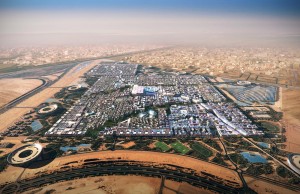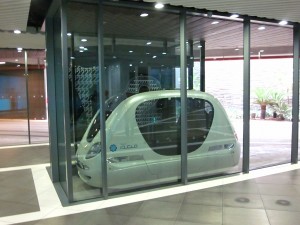http://www.youtube.com/watch?v=FyghLnbp20U
Masdar City is an arcology project in Abu Dhabi, in the United Arab Emirates. Its core is a planned city, which is being built by Masdar, a subsidiary of Mubadala Development Company, with the majority of seed capital provided by the Government of Abu Dhabi. Designed by the British architectural firm Foster and Partners, the city relies on solar energy and other renewable energy sources. Masdar City is being constructed 17 kilometres (11 mi) east-south-east of the city of Abu Dhabi, beside Abu Dhabi International Airport. Masdar City will host the headquarters of the International Renewable Energy Agency (IRENA).The city is designed to be a hub for cleantech companies. Its first tenant is the Masdar Institute of Science and Technology, which has been operating in the city since it moved into its campus in September 2010.
Masdar is a sustainable mixed-use development designed to be very friendly to pedestrians and cyclists.
Masdar City has terracotta walls decorated with arabesque patterns. From a distance, Masdar City looks like a cube. The temperature on Masdar’s streets is generally 15 to 20°C cooler than the surrounding desert. The temperature difference is due to Masdar’s unique construction. A 45-meter high wind tower modelled on traditional Arab designs sucks air from above and pushes a cooling breeze through Masdar’s streets. The site is raised above the surrounding land in order to create a slight cooling effect. Buildings are clustered close together in order to create streets and walkways shielded from the sun.
Masdar City was designed by Foster and Partners. Foster’s design team started its work by touring ancient cities such as Cairo and Muscat in order to see how they kept cool. Foster found that these cities coped with hot desert temperatures through shorter, narrower streets usually no longer than 70 meters. The buildings at the end of these streets create just enough wind turbulence to push air upwards, creating a flushing effect that cools the street.
The initial design banned automobiles, as travel will be accomplished via public mass transit and personal rapid transit (PRT) systems, with existing road and railways connecting to other locations outside the city. The absence of motor vehicles coupled with Masdar’s perimeter wall, designed to keep out the hot desert winds, allows for narrow and shaded streets that help funnel cooler breezes across the city.In October 2010 it was announced the PRT would not expand beyond the pilot scheme due to the cost of creating the undercroft to segregate the system from pedestrian traffic. Subsequently, a test fleet of 10 Mitsubishi i-MiEV electric cars was deployed in 2011 as part of a one-year pilot to test a point-to-point transportation solution for the city as a complement to the PRT and the freight rapid transit (FRT), both of which consist of automated electric-powered vehicles.
Under a revised design, public transport within the city will rely on methods other than the PRTs. Masdar will instead use a mix of electric vehicles and other clean-energy vehicles for mass transit inside the city. The majority of private vehicles will be restricted to parking lots along the city’s perimeter. Abu Dhabi’s existing light rail and metro line will connect Masdar City’s centre with the greater metropolitan area.
http://en.wikipedia.org/wiki/Masdar_City


